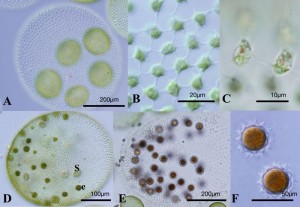Linnaeus did not examine Japanese Volvox species A new method for Volvox species classification

Volvox is a well-known alga that forms spherical colonies, but its species identification has been very difficult because while the morphological characteristics of sexually differentiated spheroids and cells were taken to be the important taxonomic criteria, the induction of sexual reproduction of Volvox in culture is generally difficult.

One of the two new Japanese species of Volvox, V. kirkiorum (Nozaki et al.) originating from Gifu Prefecture, Japan. © Hisayoshi Nozaki
(A) Asexual spheroid with five daughter colonies. (B) Optical section of somatic cells with thick cytoplasmic bridges characteristic of V. globator Linnaeus and its related species. (C) Side view of somatic cells showing their ovoid cell shape that is different from the flattened cell shape of V. globator. (D) Monoecious (having both male and female sexual organs on the same organism) sexual spheroid with sperm packets (S) and eggs (e). (E) Mature sexual spheroid with ca. 50 zygotes. (F) Mature zygotes showing characteristic acute spines of cell wall. Although V. globator produces a similar monoecious sexual spheroid, it has rounded tips of the zygote wall spines. Based on the present study by Associate Professor Nozaki’s group.
In 1758 Linnaeus described the type species of Volvox, V. globator, and various Japanese books and encyclopedias list V. globator as a species growing in Japanese inland waters. However, detailed taxonomic studies on Japanese samples of V. globator have not been carried out since Ishikawa’s 1892 report of this species from Japan.
Here, Associate Professor Nozaki’s group has established a new method to classify species of Volvox based on the induced formation of sexually-differentiated spheroids in culture, and DNA sequence data. The group examined many cultured samples originating from various localities of Japan, and finally delineated them as two new species of Volvox that are related to but essentially different from V. globator.
This is the first DNA delineation of Volvox species related to V. globator. The objective recognition of the two new Japanese Volvox species will contribute much to our understanding of biodiversity in Japan and to preservation of biodiversity of aquatic organisms. Further new species of Volvox will be discovered worldwide using the new taxonomic method established here.
Press release (Japanese)
Paper
Nanako Isaka, Hiroko Kawai-Toyooka, Ryo Matsuzaki, Takashi Nakada and Hisayoshi Nozaki,
“Description of two new monoecious species of Volvox sect. Volvox (Volvocaceae, Chlorophyceae), based on comparative morphology and molecular phylogeny of cultured material”,
Journal of Phycology 4: 2012 (in press). doi: 10.1111/j.1529-8817.2012.01142.x.
Article link
Links
Department of Biological Sciences
Keio University Institute for Advanced Biosciences
Takashi Nakada personal website (Japanese)





